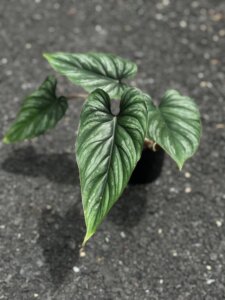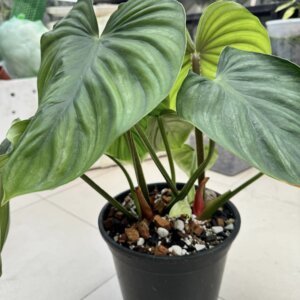Basic Information
Philodendron Plowmanii is an intriguing ovoid plant belonging to the Araceae family, known for its large and diverse plant species. It came from Ecuador and Peru and was named after a botanist, Timothy Charles Plowman. The stem of this plant has a unique habit, often referred to as “repent,” because it grows horizontally along the ground. The stem has leaf nodes where the roots and petioles of a plant would typically form.



Light
Philodendron Plowmanii thrives in an environment with bright, indirect light. It is adaptable to different lighting conditions but requires protection from harsh direct sunlight, which can damage its leaves. A location near east or west-facing windows, where sunlight is filtered through sheer curtains. This placement ensures the plant receives enough light for growth and health without the risk of leaf burn. Occasional rotation of the plant helps promote even growth and prevents the plant from leaning toward the light source.
Water
The watering needs of Philodendron Plowmanii vary with changes in home temperature and humidity. It’s essential to water the plant when the top 1-2 inches of soil become dry. Overwatering, indicated by yellow leaves, can lead to root rot, while under-watering may cause the leaves to droop. The plant generally requires more frequent watering during the warmer, growing months of spring and summer and less during the cooler, dormant period of fall and winter. Ensuring proper drainage is crucial to avoid waterlogging.
Soil
Philodendron Plowmanii requires a soil mixture that provides moisture retention and good drainage. A blend of potting soil, sphagnum or peat moss, and perlite or orchid bark is ideal. This mix ensures the roots have access to necessary moisture without the risk of waterlogging. The plant prefers slightly acidic soil, with a pH range of 4.5 to 6, which supports its growth and health.
Temperature
The Philodendron Plowmanii prefers a warm temperature range of 60°F to 88°F, typical of its tropical origin. It is sensitive to cold and should be protected from temperatures below 55°F. Signs of temperature stress include drooping or yellow leaves. Maintaining a consistent temperature within this range helps the plant stay healthy and vibrant.
Humidity
This plant, originating from a tropical environment, favors high humidity levels, ideally around 60% or higher. To increase humidity, especially in drier home environments, one can group it with other plants, use a pebble tray with water, or employ a humidifier. These methods help in creating a more suitable microclimate around the plant, promoting its lush growth.
Fertilizer
During its active growth in spring and summer, Philodendron Plowmanii benefits from monthly fertilization with a balanced, water-soluble fertilizer. In the dormant months of fall and winter, fertilization should be reduced or stopped. Slow-release fertilizers are particularly effective, providing a steady supply of nutrients over time. This approach ensures the plant receives the nourishment it needs without the risk of over-fertilization.
Growth Rate
The Philodendron Plowmanii exhibits a slow to moderate growth rate, depending on its care and environment. This creeper plant can eventually grow up to 8 feet tall and 5 feet wide, but this takes time and optimal care. Its growth pattern is horizontal, spreading across the surface rather than vertically. Proper care and favorable conditions are key to achieving its full growth potential.
Pet Safety
Philodendron Plowmanii is toxic to pets. Keep it out of their reach to ensure their safety.
Grow in Semi-Hydro
- Philodendrons, celebrated for their lush foliage and adaptability, thrive in semi-hydroponic systems such as LECA/Pon, thanks to their resilient root systems and preference for consistent moisture.
- Shifting a Philodendron to a semi-hydroponic setting works well using a Nutrient Stagnant Wicking (NSW) method, providing a stable and effective environment for growth.
- Within the LECA/Pon environment, Philodendron roots adapt swiftly, effectively managing any early challenges in adapting to the NSW system.
- For nourishing Philodendrons in semi-hydro systems, a nutrient solution with a concentration around 800-1000ppm is optimal.
- Philodendrons are versatile in adapting to a range of temperature and humidity levels, making them ideal for various indoor settings.
- Regular care involves keeping an eye on the water level in the reservoir and periodically flushing the system to ensure the Philodendron’s healthy and consistent growth.
- If your Philodendron is a climber, it’s a must to look at our Moss Pole guide to have a proper set-up.
Tips
- Necessary every 1-2 years or when roots outgrow the pot. Use a pot with good drainage, slightly larger than the current one.
- Prune dead or yellow leaves to maintain health. It is best done in spring.
- Look out for aphids and spider mites. Treat with neem oil or insecticidal soap.
- It is best propagated through stem cuttings in water or soil during the growing season.
- Avoid letting the plant sit in water. Ensure good air circulation to prevent pest infestations and diseases.
Ensuring the Philodendron Mayoi thrives in an indoor environment, bringing tropical greenery to your space, requires attention to several key aspects.
Happy planting! 🌱


